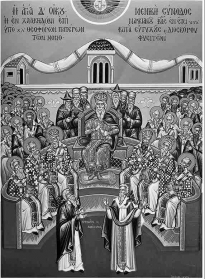History of Doctrines II
An introduction to the literature and themes of the patristic period, from the first to the seventh centuries. Emphasis will be on reading and discussing primary sources in translation. The primary themes to be pursued are the formation of Christian doctrine of God, Christ, salvation, and eschatology; the church, specifically, its character, worship, structure, and relation to the world; spiritual life, especially ascetical and monastic differentiations; the interpretation of the bible; finally, the relation of faith and culture.
The material of the second semester presents mainly the importance of the theologians and theological controversies mainly from the fifth century.
Competences
Specific competences
The student will see the process of formation of the christian doctrines, and will be able to see and evaluate each doctrine in its historical and cultural context.General competences
With the historical vision formed during the classes, the student will be able to draw up the christian message for his own age and theological-cultural context.Course structure
-
The theological School of Antioch: its early representants, the life and sigificance of Diodor of Tarsus
-
The life, teaching and theological sigificance of Theodor of Mopsuestia
-
The life, teaching and theological sigificance of John Chrysostom
-
The Latin theological teaching before 431: Hilary of Poitiers; Jerome and the Vulgata; Ambrose of Milan
-
The life, teaching and theological sigificance of Aurelius Augustinus
-
The theological controversy of Alexandria and Antioch: Cyril of Alexandria and Nestorius; theological controversies and eclesio-political fights
-
The 12 anathemas of Cyril, the Letter of Ibas of Edessa; the comparision of the christology of Cyril and of the antiochians
-
The Council of Ephesus in 431 and its consequences
-
The monophysite controversy; the life and theological importance of Theodoret of Cyrus; the Council of Constantinpole in 448; the Creed of Flavian; the persecution of the orthodox theologians
-
Pope Leo I and his Tomus ad Flavianum; The "robber synod" of Ephesus in 449 and its consequences
-
The 4th Ecumenical Council of Chalcedon in 451; its convocation and the authority of Pope Leo; the events of the council from its beginning to the fourth session (deposition of Dioscore, the reception of the Tomus ad Flavianum).
-
The events of the Council of Chalcedon 451: from the fifth session to the end of the Council (the Definition of Chalcedon; the rehabilitation of Theodoret of Cyrus and of Ibas of Edessa; the Patriarchate of Jerusalem).
-
The Canons of the Council of Chalcedon; Canon 28 and the growing authority of Constantinople (the new Rome)
-
The sunset of the patristic age
Total estimated time
Classroom study
- 2 hours/week (Course: 2 | Seminar: 0 | Practice: 0)
- 28 hours/semester (Course: 28 | Seminar: 0 | Practice: 0)
Individual study
- Time for studying course notes and bibliography: 50 hours/semester.
- Time for further documentation in libraries, electronic platforms, or on the field: 15 hours/semester.
- Time for preparing essays, papers, or documentation: 7 hours/semester.
- Time for personal tutoring: 3 hours/semester.
- Total individual study: 75 hours/semester.
- Total estimated time: 103 hours/semester.
Examination
Oral exam based on the content of the classes an on the primary literature.
